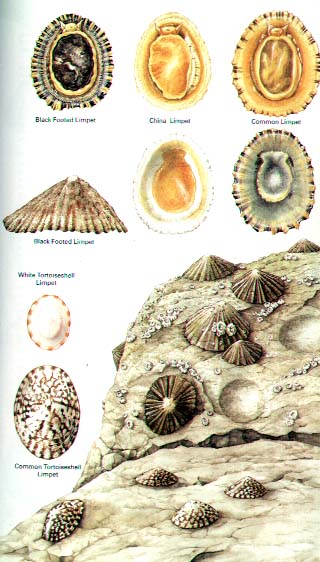
 |
Onchidoris
bilamellata (sea slug) & Patella vulgata
Limpets from around the British Isles.
Patella
vulgata
British species of Patella:
Patella depressa Black-footed Limpet
Advice for recorders of Patella depressa
Patella vulgata Common Limpet
This is the common species of limpet that is found on all rocky shores around the British Isles. It will also be found attached to groynes, wharves and piers in sandy areas. It is an important grazer of microalgae on the shore. If the limpets are killed by oil pollution, the weed growth will be entensive for at least 3 years until the limpets can return to their former numbers.
Patella ulyssiponsensis China Limpet (=P.aspera)
Mediterranean species
Species
not identified
Patella coerulea
Patella lusitania

A
Guide to Limpet Identification for the general naturalist
by Jan Light
As Marine Recorder for the Conchological Society of Great Britain & Ireland it is my ‘job’ to solicit records of marine molluscs. The Society has a history of keeping distributional records for molluscs which spans 120 years for nonmarine species and 75 years for marine species. Because of the longevity of the scheme there is often an assumption that most of the work is done and that records for common species are not needed or valued. This is emphatically not the case. Whilst it is true that a record for a rare species is exciting for all parties, persistent records for the commoner species give a picture of the stability of all those molluscs species which make up the background of the picture of a given habitat or site. So it is with limpets. But there is more. Often limpets are recorded as such, or Patella vulgata and there is often no attempt to separate the 3 Patella species. The distribution of 2 of them is not continuous around the British Isles and is therefore of particular interest. In an effort to encourage more precision in limpet recording I give a straightforward guide to separating these animals in the field.
Various field and identification guides give details of differences in the shells of the 3 species. These differences concern the overall outline of the outer limit of the aperture, the degree of conicalness or depression of the apex, and the numbers and arrangement of ribs. With practice it is possible to discern these differences and make accurate judgements based on exterior appearance but it is not foolproof even for the ‘experts’. The best way to identify limpets is to look at the soft parts and this need not be a destructive business. Even if the shell is not slightly raised above the rock surface during movement, the unwary limpet can be flipped over with the edge of a knife. This need not damage the shell or the animal inside. Once inverted the animal can be viewed from below. The dominant structure is the oval foot and at the anterior you will see the head with short tentacles and the mouth. Around the foot, and lining the interior of the shell is the mantle with short pallial tentacles forming a fringe at the edge. It is the foot and mantle which bear the distinguishing features. In Patella vulgata, the commonest species, the foot is greenish grey or yellowish and this may be pale or quite dark. The pallial tentacles are more or less transparent. In Patella ulyssiponensis (formerly aspera) the foot is apricot coloured through to cream. Younger animals especially are the paler colour. There is no hint of green. Additionally the pallial tentacles (as distinct from the head tentacles) are ticked with creamy white markings. In Patella depressa the foot is black or very dark grey and again there are white ticks on the pallial tentacles of the darkish mantle. It is advisable to look for adult animals since these show the colour differences most strikingly. In the course of my own field recording I frequently come across animals which show other combinations of these colour features. These are not ‘hybrids’ but examples of ‘morphologically convergent’ animals. They would be identifiable based on the radula but when field recording they are best replaced on their muscle scars and a search continued for typical specimens of all 3 species. A final hint on finding all 3 species on a shore concerns zonation. Patella vulgata can be found at all levels of the shore but is generally more numerous on the upper shore right up into the splash zone. Patella ulyssiponensis is a lower shore species but is also found in permanently submerged pools higher up. Patella depressa is essentially a mid-shore species. There is an excellent plate showing the 3 species viewed from below in ‘A Student’s Guide to the Seashore’ by J D Fish and S Fish.
Finally, a word on distribution around the British Isles. Patella
vulgata occurs all round the coasts. The eastern limit of both
P.
depressa and P. ulyssiponensis in the English Channel is Bembridge
on the Isle of Wight. Patella ulyssiponensis ranges up the
western seaboard of the British Isles and around the coast as far south
as Flamborough Head on the east coast. Patella depressa
is
more restricted however. West from Bembridge it occurs only as far
north as Anglesey on the west coast of Wales, is unconfirmed from Ireland
and has only recently been recognised in Scilly. Recognition of extensions
of distribution of these 2 restricted species, therefore, would be particularly
interesting - shore watchers in the Eastern English Channel especially,
take note.
Patella Page (external site)
This is from the new Collin's Pocket Guide to the Seashore
(click on the image for further details of this essential book)
We find our Triggerfish, Corkwing
and
Ballan
Wrasses readily eat and forage for any limpets in the big tank.
Regards
Jenny Nunn
Axmouth Sea Discovery Centre, Devon (east) Web Site
|
|
|
|
|
News 2018 |
Membership Form |
|